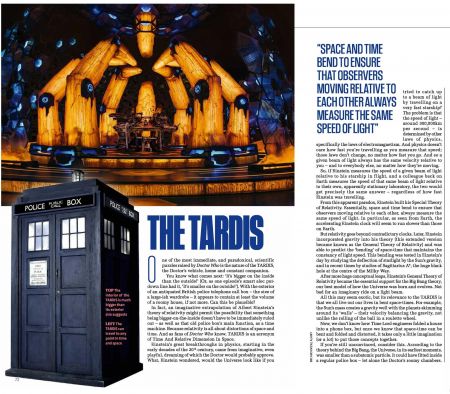The Tardis
- Publication: BBC Science Focus
- Date: Nov. 2023
- Author:
- Page: 72
- Language: English
One of the most immediate, and paradoxical, scientific puzzles raised by Doctor Who is the nature of the TARDIS, the Doctor's vehicle, home and constant companion.
You know what comes next: 'It's bigger on the inside than the outside!' (Or, as one episode's smart alec put-down line had it, 'It's smaller on the outside!'). With the exterior of an antiquated British police telephone call box — the size of a large-ish wardrobe — it appears to contain at least the volume of a roomy house, if not more. Can this be plausible?
In fact, an imaginative extrapolation of Albert Einstein's theory of relativity might permit the possibility that something being bigger-on-the-inside doesn't have to be immediately ruled out — as well as that old police box's main function, as a time machine. Because relativity is all about distortions of space and time. And as fans of Doctor Who know, TARDIS is an acronym of Time And Relative Dimension In Space.
Einstein's great breakthroughs in physics, starting in the early decades of the 20th century, came from imaginative, even playful, dreaming of which the Doctor would probably approve. What, Einstein wondered, would the Universe look like if you tried to catch up to a beam of light by travelling on a very fast starship? The problem is that the speed of light—around 300,000km per second — is determined by other laws of physics, specifically the laws of electromagnetism. And physics doesn't care how fast you're travelling as you measure that speed; those laws don't change, no matter how fast you go. And so a given beam of light always has the same velocity relative to you — and to everybody else, no matter how they're moving.
So, if Einstein measures the speed of a given beam of light relative to his starship in flight, and a colleague back on Earth measures the speed of that same beam of light relative to their own, apparently stationary laboratory, the two would get precisely the same answer — regardless of how fast Einstein was travelling.
From this apparent paradox, Einstein built his Special Theory of Relativity. Essentially, space and time bend to ensure that observers moving relative to each other, always measure the same speed of light. In particular, as seen from Earth, the accelerating Einstein clock will seem to run slower than those on Earth.
But relativity goes beyond contradictory clocks. Later, Einstein incorporated gravity into his theory (this extended version became known as the General Theory of Relativity) and was able to predict the 'bending' of space-time that maintains the constancy of light speed. This bending was tested in Einstein's day by studying the deflection of starlight by the Sun's gravity, and in recent times by studies of Sagittarius A*, the huge black hole at the centre of the Milky Way.
After more huge conceptual leaps, Einstein's General Theory of Relativity became the essential support for the Big Bang theory, our best model of how the Universe was born and evolves. Not bad for an imaginary ride on a light beam.
All this may seem exotic, but its relevance to the TARDIS is that we all live out our lives in bent space-times. For example, the Sun's mass creates a gravity well with the planets skimming around its 'walls' — their velocity balancing the gravity, not unlike the rolling of the ball in a roulette wheel.
Now, we don't know how Time Lord engineers folded a house into a phone box, but once we know that space-time can be bent and folded and distorted, it takes only a little imagination (or a lot) to put those concepts together.
If you're still unconvinced, consider this. According to the theory behind the Big Bang, the Universe, in its earliest moments, was smaller than a subatomic particle. It could have fitted inside a regular police box — let alone the Doctor's roomy chambers.
TOP The interior of the TARDIS is much bigger than its exterior size suggests
LEFT The TARDIS can travel to any point in time and space
Disclaimer: These citations are created on-the-fly using primitive parsing techniques. You should double-check all citations. Send feedback to whovian@cuttingsarchive.org
- APA 6th ed.: (Nov. 2023). The Tardis. BBC Science Focus p. 72.
- MLA 7th ed.: "The Tardis." BBC Science Focus [add city] Nov. 2023, 72. Print.
- Chicago 15th ed.: "The Tardis." BBC Science Focus, edition, sec., Nov. 2023
- Turabian: "The Tardis." BBC Science Focus, Nov. 2023, section, 72 edition.
- Wikipedia (this article): <ref>{{cite news| title=The Tardis | url=http://cuttingsarchive.org/index.php/The_Tardis | work=BBC Science Focus | pages=72 | date=Nov. 2023 | via=Doctor Who Cuttings Archive | accessdate=5 December 2025 }}</ref>
- Wikipedia (this page): <ref>{{cite web | title=The Tardis | url=http://cuttingsarchive.org/index.php/The_Tardis | work=Doctor Who Cuttings Archive | accessdate=5 December 2025}}</ref>

